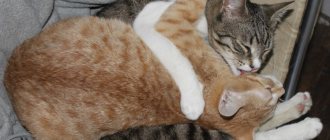Some habits are quite natural behavior after mating, although they may cause some surprise from a human point of view. But others may indicate a developing disease. Let's consider the question in more detail.
Why does a cat still “flow” after mating?
In fact, everything is natural and natural. Usually, for several hours and even days after coitus, the female will behave restlessly, still purring, rolling on the floor and lifting her tail when any touch to the rump.
The phenomenon is explained simply: during estrus, a huge amount of sex hormones are released into the blood, and it takes some time for the body to adjust to its normal mode. Ovulation occurs somewhere 24-36 hours after intercourse, it is quite logical that the animal will still be in heat for at least a day and then it will take another 2-3 days for all the accompanying symptoms to subside.
In such cases, they focus on the cat’s behavior. If he has lost all interest in the imported bride, then ovulation has occurred and the expectant mother can safely be taken home.
Sometimes, even after successful fertilization, the female experiences repeated estrus (superfetation) and again asks for a cat. The phenomenon is associated with decreased progesterone levels during the current pregnancy. Under no circumstances should repeated mating be allowed, especially if 2 months (65-70 days) have not yet passed since the previous one, otherwise there will be two batches of embryos of different ages in the uterus at once. There are two possible developments:
- timely birth, while the younger litter dies;
- the cat first gives birth to the first litter, and a few weeks later the second.
When to start mating
When does a cat start asking for a cat? The answer depends entirely on the physiology of the pet. In practice, females can bear offspring approximately once every six months. The first estrus begins 7-8 months after birth. But it's not that simple.
Depending on the individual characteristics of the body, it can begin much later or even earlier. In any case, it is almost impossible to control the process .
A cat can scream and ask for a cat, oddly enough, at any time of the year. The best time to bear kittens is between the cat's 2nd and 5th birthday. In theory, a female can give birth for up to 10 years. But after the 7th year, frequent anomalies in the development of the offspring are observed, and the likelihood of miscarriage increases. Therefore, the best period for the first pregnancy will be the third heat.
ATTENTION! If a young purr is too timid and cautious, then it is better to mate with an experienced gentleman. As a rule, the female does not allow the cat to approach her for some time. Up to several days
You probably won't be able to get pregnant right away. Potential partners should be introduced. It will take several meetings for the future parents to get to know each other better. Meetings don't have to be long. The maximum travel time is limited to an hour. It is better to focus on the frequency of meetings rather than the duration.
It is important to note that the cat must feel like he is in charge of the situation. It is better if the mating takes place on his territory. During the period of acquaintance, he can actively mark his territory. If a cat is taken to a cat to mate, then he definitely needs to get comfortable. The owners of the female will have to endure forced inconveniences in the form of fur, yelling and active arrangement of the guest in the apartment.
The mating room should be spacious and bright. It is advisable not to disturb partners during the meeting and remove other animals and children from the premises. Cats can be extremely shy. Such caution can greatly affect the mating and reduce it to nothing.
Several matings can occur between partners (up to 10), but this does not guarantee that the female will become pregnant, even if the cat is absolutely healthy
Sexual viability
The ability to reproduce in representatives of the cat family is called sexual maturity. Females reach this state by 6-8 months, males - 4-5 weeks later. The sexual hunt begins: “girls” go into heat, and “boys” have an increase in testosterone levels, which is manifested by increased aggression and marking of territory.
However, the time has not yet come for the first mating at such a “tender” age. Risk factors for premature mating include:
- slower growth and development;
- deterioration in appearance;
- complications of pregnancy and childbirth;
- the birth of weak or stillborn babies;
- the threat of infertility (for “girls”) and impotence (for “boys”).
For romantic dates, you need to wait for structural formation, physiological and psychological maturity. The optimal age of a cat for the first mating is 14-15 months. At this point, Murka is going through 2-3 heats.
It’s also not worth delaying fertilization. You can’t let your pussy stay “in the girls” for too long. Owners who delay untying their pet for up to one and a half years should be aware of the possible consequences for its health:
- polycystic disease;
- inflammation of the uterus;
- false pregnancies;
- stress;
- exhaustion.
“Grooms” are physiologically ready to perform reproductive functions at the age of 12-13 months.
Puberty of cats: castration or hormonal drugs
What happened? The kitten just became an adult.
What is puberty
Animals, like humans, enter puberty, when the body's hormonal levels change and it becomes ready for reproduction. In cats it occurs at 7-8 months and sexual heat begins. By human standards, this is 7-10 years, but unlike humans, animals at this age are already ready to mate. Cats begin to go into heat, repeating every 3-4 weeks, the cat needs a female, and constantly.
Signs of heat
During the period of sexual hunting, the behavior and character of the pet changes greatly. There are many signs that an animal needs mating:
- both male and female cats become aggressive;
- scream (meow invitingly), especially at night;
- cats begin to mark their territory (i.e., leave urine marks throughout the house);
- cats become intrusive, constantly rub against the owner or pieces of furniture, walk on half-bent legs, raising their butts, their tail is constantly raised;
- animals tend to go outside (even those who have never been there);
- become disobedient and may start doing dirty tricks;
- cats often refuse to eat.
If in a cat these symptoms appear and last only during the period of estrus, then in cats the sexual heat lasts a whole year, which means that screams, marks and other “charms” of sexual heat will constantly torment the owners. Moreover, even if you bring a cat together with a cat, this will not discourage him and will not “make him sad.”
Both male and female cats suffer if mating does not occur, so owners need to solve this problem as quickly as possible. And there are three ways to solve it:
- provide animals with complete freedom and access to the street (or constantly bring the animals together);
- spay or neuter your pet;
- Constantly give the animal hormonal drugs that reduce libido.
The first option is not suitable for everyone: complete freedom of the animal is fraught with consequences (lichen, worms, fleas, various diseases that the pet brings from the street), and the kittens will need to be placed somewhere. Therefore, the choice is mainly between castration (sterilization) and drugs.
Pros and cons of castration (sterilization)
A very common and effective way to neutralize the animal's need to mate and reproduce. These procedures are performed surgically. Moreover, castration and sterilization are radically different.
Sterilization is considered more humane and safe than castration. Animals of both sexes can be sterilized, but it is more suitable for cats. The essence of this operation is to ligate the fallopian tubes in cats and the seminal canals in cats, that is, the reproductive organs of the animals are not removed. Sterilization only results in the inability to reproduce, but does not prevent the release of sex hormones, and therefore does not solve behavioral problems.
In addition, sterilization also has a number of negative consequences:
- the risk of breast and testicular cancer increases;
- problems with the urinary system may appear;
- Animals may also experience prostatitis and inflammation of the uterus.
Castration is a radical method; during this operation, the seminal glands are completely removed in cats, and the uterus and ovaries in cats. Although this method seems cruel, it is very effective. Since the organs responsible for the production of sex hormones are removed, all problems associated with the pet’s behavior disappear. He becomes affectionate and calm again. In addition, thanks to the castration procedure, the animal’s lifespan increases, its mental abilities increase, and the risk of diseases of the genitourinary system decreases. But there are several reasons why owners are afraid to subject their pets to this procedure:
- obesity may develop;
- the animal may not tolerate anesthesia;
- there is a risk of kidney stones;
- Heart disease develops with poor diet.
Hormonal drugs to reduce libido
Recently, more and more cat owners are inclined to solve the problems of sexual heat with the help of special medications, which are available in the form of tablets or drops. Indeed, this method allows you to avoid surgical intervention in the pet’s body and the associated consequences (what it takes for the animal to survive anesthesia). A lot of pharmaceutical companies produce such drugs, the choice is great and the price is also different. But it is important to understand that the cheaper the medicine, the more contraindications and side effects it has (cheap cannot be good).
It is also advisable that the drug be selected by a veterinarian, taking into account the age, weight, breed and health status of the cat. After all, this is also a kind of medicine that may, at best, simply not be suitable, or at worst, seriously harm the animal.
The disadvantage of such drugs is the high concentration of hormones, which, if used for a long time, can cause hormonal imbalances and aggressiveness in the cat’s body. And after the first use, the animal will not be in the best shape - the drugs cause general lethargy and detachment. Of course, only the owner can decide which method to choose to reduce the pet’s sex drive. But, the main thing is not to forget that we are responsible for those we have tamed, and are responsible for their safety, health and life.
After mating, the cat vomits, diarrhea, does she have a fever?
Such symptoms, although quite rare, do occur. Why is this happening?
- Consequences of stress: change of environment, rampant hormones, etc.
- Stomach upset as a result of a sudden change in food, if the owners of the female for some reason forgot to transfer the usual food to the temporary place of residence.
- Food poisoning, poisoning, which are in no way related to cages, but are a coincidence of two phenomena in time.
Very rarely, if cat owners are negligent about vaccination, a cat can pick up a pathogenic virus in someone else’s home. There have been cases when, after mating, a female became infected with calcivirosis, rhinotracheitis, panleukopenia, rhintotracheitis, etc.
That is why it is so important to check the breeder’s veterinary passport before mating and inquire about the vaccinations given. Even a healthy-looking cat, which is full of strength and energy, can turn out to be an “incubator” (a carrier of the virus) and transmit a terrible and dangerous disease to its lover. By the way, cat owners should also not forget about preventive vaccination.
The best time for mating
So, cat owners should remember the basic rule: the optimal age for a cat’s first birth is 12 months (accordingly, mating can take place starting from 10 months), the critical period after which prolongation becomes dangerous for the cat’s health is four heats (maximum on the fifth successful mating must occur).
Important! Often, cat owners, unable to withstand the endless hysterical screams of their current pet, give her various drugs that suppress sexual activity. Despite the assurances of pet store sellers and even professional veterinarians about the complete safety of such medications, this should not be done under any circumstances, since in fact such an intervention can affect both the reproductive function of the animal and its general health, and may manifest itself pathology may not be immediate
A cat is not suitable for breeding until a full 12 months, but it is also not worth delaying for more than two years, this is harmful to the health of the animal and the nervous system of its owners.
Solving problem situations
In the affairs of amorous animals, not everything goes smoothly. In some cases, a couple needs help from:
- The cat hisses at the cat when mating. There is no need to rush animals, especially inexperienced ones. They need more time for foreplay.
- The cat is smaller in size than its partner, as a result of which the cat rests on its back. In this case, it is necessary to send the male.
- The bride falls on her side during sexual intercourse. In such a situation, they support the female.
We suggest you read: What to feed a castrated cat with natural food. Feeding a cat after castration: features of natural and industrial nutrition
When does that very moment of mating come?
Cats need to select an experienced female for the first mating. Although in practice, even a couple of untied feline representatives will cope with the task. The reproductive instinct in animals is incredibly strong, it is almost a basic need.
After mating, the male needs time to rest and recuperate. You also need to feed your cat nutritious and balanced food. The health of the pet during the mating period must be carefully monitored: be observed by a veterinarian, check for infections and viruses, carry out deworming measures and vaccinations, get rid of ticks and fleas. Prevention measures are also important. The doctor issues a certificate about the pet’s condition; this document will give a guarantee to the female and increase the reputation of the cat’s owner.
During the period of acquaintance with the “groom” and mating, the cat must be in heat, otherwise there will be no mating. If possible, both cats' claws are trimmed to prevent injury.
We invite you to familiarize yourself with: Play complex for cats: buy or make it yourself
False pregnancy after mating
False pregnancy is harmful to the cat. Unlike dogs, false pregnancies do not occur as often in cats. Its occurrence is preceded by sterile sexual intercourse, that is, when the reproducer has some problems with the seminal fluid, for example:
- low sperm motility;
- complete absence of “little creatures” due to frequent use or inflammation;
- pathological forms of male cells or their non-viability.
Like a normal pregnancy, a false pregnancy is accompanied by:
- cautious behavior;
- nipple enlargement;
- swelling of milk cartons;
- rounded belly;
- After the due date, the cat “gives birth” and produces milk.
It is clear that imaginary tightness is very harmful for the female: the psyche and general condition of the body suffer, and hormone levels are disrupted.
How to avoid? Before uniting loving hearts, it is necessary to be interested in the male health of the inseminator, the fate of his former partners (in terms of whether they became pregnant or not), and the presence of offspring from other females.
Castration of a cat is a radical remedy against estrus
The best alternative, in terms of effectiveness, to taking hormonal drugs during estrus is castration. Such a surgical operation is intended to once and for all “turn off” the animal’s reproductive function in order to calm it down and help the unfortunate person finally cope with the unrealized reproductive instinct.
Unlike sterilization, after which the female is deprived of the opportunity to have kittens, but still suffers from hormonal changes associated with estrus, castration involves the removal of all the internal organs of the pet responsible for reproduction. In practice, this means a complete cessation of estrus and the accompanying problems.
A castrated animal no longer wants to mate at all, does not leave odorous marks on the furniture and does not try to attract the cat with its cries (which will certainly please the owners). The most important thing is that the female no longer experiences physiological and emotional discomfort due to the lack of “dates” in her life.
In short, castration is a very humane and reliable means of combating unwanted symptoms of cat estrus. Veterinarians definitely recommend this method to everyone who does not plan to use the animal to produce breeding offspring. Fortunately, such operations today are completely safe and do not cause any harm to the health of cats (including in the long term).
A sterilized cat asks for a cat: 4 reasons
There are the following causes of estrus in sterilized females:
- Incomplete removal of epididymal tissue. Occurs when an unremoved piece of ovarian or epididymal tissue remains, which is capable of regenerating and partially replacing the internal secretion organ. Estrus occurs as usual, but pregnancy does not occur and the pet will not be able to bring kittens. Repeated surgery, as a rule, does not solve the problem. Not every veterinarian is able to find the criminal piece of tissue, and repeated anesthesia will harm the cat’s health. However, the chance of achieving a positive result increases if the uterus and surrounding tissue are removed.
- Development of the reminant ovary. After the removal of the reproductive organs, the pituitary gland or adrenal glands begin to produce sex hormones. Statistics show that one out of seven castrated cats can retain the ability to secrete estrogen.
- Congenital anomaly. Cells of the ovarian appendages take root in other organs.
- Development of a hormone-like tumor. The neoplasm has the ability to secrete estrogens. Pathology is observed in cats that were castrated in adulthood.
Be sure to read: How to care for a cat after sterilization: blanket, diet, treatment and removal of sutures
Should there be discharge after mating?
This is where it’s worth going into more detail. The fact is that discharge from the genitals after mating in cats is normal in some cases, but in others it is a very serious signal that there is a pathology in the body.
Usually, another 2-3 days after the cage, you can observe transparent, watery mucus - this is the norm and the result of a still ongoing estrus. This phenomenon should not bother owners.
But the appearance of dirty, brown, viscous discharge mixed with blood and an unpleasant odor is a very bad and unfavorable symptom. What it could mean:
- abortion;
- sexual infection;
- inflammatory processes in the reproductive organs (gynecological diseases).
Abortion can occur at longer periods or just a few days after mating. He can wear:
- infectious etiology, the same sexually transmitted infections (brucellosis, chlamydia, toxoplasmosis, plague);
- and non-contagious, when there are abnormalities of intrauterine development, endocrine disorders (reduced secretion of progesterone), intoxication, the use of drugs that affect the functioning of smooth muscles, various injuries or hypothermia.
With different types of abortion there will be different signs. You can indirectly judge an impending miscarriage by the appearance of dark green discharge mixed with blood. In any case, consultation with a specialist and pelvic ultrasound are necessary to make a diagnosis.
Gynecological diseases arise as a result of the influence of various factors, in particular secondary microflora. Opportunistic microorganisms present both on the male penis and in the female vagina are the cause of opportunistic infections that lead to inflammatory processes in the reproductive organs.
For a healthy animal, the presence of these microbes does not pose any danger. If a cat has microtraumas on the reproductive organs, immunity is reduced, then the natural defense weakens, “foreign” bacteria transmitted by the cat during sexual intercourse begin to multiply rapidly, leading to diseases such as vaginitis, metritis, pyometra, endometritis, oophoritis and etc.
In most cases, gynecological diseases are accompanied by discharge and subsequent pregnancy failure, if it occurs at all. Therefore, it is so important to carry out periodic examinations before mating, to treat the animal in a timely manner for any inflammation, in order to be confident in the health of the pet and her ability to bear healthy offspring.
Mating cats - features and stages
It is impossible to predict in advance how the first acquaintance between a female and a male will go. Animals may immediately like each other, or they may show unmotivated aggression.
In order for pets to become friends faster, mating should be carried out in a separate, closed room.
Moreover, in a prepared area there is a greater chance that they will find a common language.
First, a container with a cat is brought into the room; she needs to be left alone for some time so that she becomes familiar with the new conditions. Only after the cat has studied everything and calmed down can the male be brought into the room. An indicator that mating will take place with the expected result is normal, typical behavior of animals. If a cat immediately began to show aggression towards each other, it is unlikely that their acquaintance will lead to anything.
If the cat likes the male, a short period of flirting begins. The animals exchange greetings, after which the cat, after petting the cat several times, allows him to come closer to her. If the female does not like the partner chosen by the owners, she will begin to behave aggressively: she will hiss and growl, and may even bite a cat who tries to come closer to her. Owners must monitor how animals behave. If aggressive behavior occurs, pets should be immediately separated and isolated.
Act of intimacy
As soon as the seals have gotten used to each other, got acquainted and exchanged greetings, after a short sexual foreplay, the female allows the male to approach her, making it clear that she is ready for sexual intercourse by standing in a specific position - with an emphasis on her hind legs, raising her pelvis and tail high . The cat approaches the female from behind, digs her teeth into her nape, and hugs her from the sides with her front paws.
The actual process of intercourse lasts very quickly, with instant ejaculation. At the same time, the cat will purr, and the female will scream heart-rendingly (this scream has its own good reasons). After sexual intercourse, the cats separate in a rather specific manner - the cat with a sharp movement jumps away from the female, who in turn hits him with her paw.
After sexual intercourse, the cat’s behavior changes dramatically – it behaves specifically and aggressively. Aggression is explained by the fact that the cat’s penis is rough, and the female experiences unpleasant, painful sensations during intercourse due to the fact that the vaginal mucosa is highly irritated.
Severe pain during sexual intercourse in a cat is also caused by the fact that the scales on the penis dig into the uterus, which is why the cat screams heart-rendingly after the act. But this irritation is necessary in order to stimulate ovulation in the cat, which begins within 24 hours after mating.
If a cat mates for the first time, there is a high chance that ovulation will not occur immediately. After the first sexual intercourse, several more intercourses must occur for the cat to become pregnant, so the animal must be left with the male for several days. Animals can experience up to 10 acts per day.
The owner should not be far from his pets during the mating period. As a result of the rather aggressive and specific behavior of the female, unforeseen situations may arise, so the presence of a person is necessary to come to the rescue in time.
What other cases are there?
The signal that the female is ready for mating is estrus. How do you know if your pussy has started sexual intercourse? She experiences obvious “languor”:
- purrs often and loudly;
- fawns or turns into an aggressive touch-me-not;
- rubs vigorously against all sorts of objects;
- takes a characteristic pose when stroking the back: the trembling tail is pulled to the side, the rear is raised, the chest falls to the floor.
The “lady” is sent to the “gentleman” on the third day after such signs appear. The guest comes with her things: food, bowls, litter tray. No one knows how long it will take to breed a cat and a cat. You need to plan for 1-3 days. The first time it may take a week.
Meeting partners rarely takes place in a warm, friendly atmosphere. Mutual ignoring, hissing, fighting are typical manifestations of cat flirting. The owner of the house should monitor the situation to prevent injury to animals.
When the “lady” gets used to it, she herself begins to flirt with the male. After waiting for the aggression to die down, you need to leave the “newlyweds” face-to-face. How long does a coitus session last? Usually “this” occurs in cats for up to 20 seconds, accompanied by heartbreaking screams. How long after can I visit my clients? It’s worth delicately waiting a couple of minutes for the disturbed duo to calm down.
We suggest you read: Diseases of peacocks and their treatment
How to understand that genital contact has occurred? Silence reigns in the room where the “young” remain. After being untied, Murka's behavior changes dramatically: she becomes tolerant of her partner, lies down next to him, rolls around on the floor, her genitals enlarge and turn red.
How many days does mating last for cats? It all depends on the character and experience of the “newlyweds”. Ambitious murki behave aggressively, shy ones huddle in a corner. The boyfriend must be given time to seduce the “lady”.
In veterinary practice, there are a number of specific cases when the sex hormonal background of a sterilized individual was determined by diseases occurring in the thyroid gland. Aligning and adjusting the balance of hormones in this situation is not an easy task, which may include a number of stages:
- Exclusion of hormone-producing tumors;
- Chemical suppression of sex hormones.
Most often, the latter is performed by implanting a special capsule under the skin.
Mating cats
Mating is a natural phenomenon for all animals, but mating between desired animals has some subtleties and complexities, as well as bureaucratic processes.
Mating is carried out on the third day after the cat starts estrus.
Suitable age for first mating is approximately 1.5 years
Proper preparation
Before mating, the spouses visit a veterinarian to examine the animal. By the way, they must be vaccinated no later than two weeks before the wedding.
Deworming and treatment for skin parasites was carried out within 10 days.
Before the wedding, the bride and groom's nails are trimmed to prevent them from injuring each other, and their fur is combed out. But you shouldn’t wash it before knitting. Shampoos wash away pheromones that attract the opposite sex.
Before mating, it is prohibited to give cats various hormonal drugs that affect estrus.
Necessary and Required Documents
Animal owners enter into an agreement that specifies the following points:
- Pedigree and achievements of future parents
- The order and duration of the bride's stay in the groom's house
- Dates of vaccination, antiparasitic treatment and a certificate from a veterinarian that the animal is healthy
- Conditions for distribution of kittens between parental owners
- Reward terms
Timely discussion of these points recorded on paper allows us to resolve the following issues:
- The female did not become pregnant
- She gave birth to non-viable offspring
- The expectant mother was seriously injured after the wedding
The pedigree of a cat is one of the important documents when breeding purebred animals.
What you need to take with you
As a rule, a cat is given to a cat's house, and not vice versa. This is explained by the fact that on his territory he feels more confident and is more likely to persuade his beloved to the marriage process than at her home. Because at the female’s home, he will first cover the entire room, get comfortable, and only then begin mating. During this time, you can lose your ovulation peak.
Therefore, the cat goes to the groom's house. What does that require:
- Tray with filler
- Bowl and food
- A carrier in which your pet can hide in a stressful situation.
How does the mating process take place?
After the bride arrives to the groom, they need a separate spacious room, preferably with a minimum of furniture.
At first, the cat may experience severe stress, hide and react aggressively to the cat. For some, before the crucial moment, signs of estrus disappear. But after she gets used to it a little and decides to explore the space.
When the female is ready for mating, a long flirtation and flirtation with the cat begins on her part.
She rolls around on the floor in front of him, rubs herself against him and attracts attention to herself in every possible way.
For a successful outcome, cats need to be mated 5-6 times
How long does the process take? Such games last about 12 hours until the cat mounts.
The animals can have intercourse for a little longer than a minute, after which they both begin to intensively lick the genitals.
For successful fertilization, animals mate at least 5 times.
After mating has taken place, the female rolls around on the floor, purrs, purrs and demonstrates in every possible way that she feels good.
The fact that mating is completed is indicated by a complete lack of interest between the animals.
The cat spends 1.5-2 days in the groom's house.
How an owner can help with mating
In some cases, animals need help from their owners. When do owners need to intervene?
- The female is significantly larger than the male. The groom grabs his bride's withers with his teeth and tries to make a mounting, his penis rests against his girlfriend's back, and does not end up in the vagina. Solution to the problem: one of the owners puts his hand on the girl’s withers, and the male has no choice but to grab it lower. As a rule, after this, coitus occurs correctly.
- The cat falls over on its side. Solution: someone holds the female to prevent her from falling. Some experienced cats can even mount in a side position.
- The samkane allows the male to approach. As they say, you can’t order your heart. In nature, females themselves choose the father of their children, and if for some reason she does not like him, then she will no longer mate with him. Neither long persuasion on the part of the male nor the holding of the bride by the owners helps. Solution: a special probe is inserted into the vagina, which provokes rapid ovulation. The bride has no choice but to let the cat come to her.
In some cases, owners have to help cats mate
How should a cat behave after mating?
There is no clear answer to this question. Each animal is an individual with its own quirks, temperament, and physical development.
Some cats can hide in a corner and lie there for several days with an indifferent look or just sleep. Perhaps it is stress from experienced emotions or simple fatigue. Screams for many days, endless intercourse make themselves felt, and the body requires rest. If the cat is sad, but otherwise everything is fine: she eats, drinks water, goes to the toilet and does not have a temperature, then there is no reason to worry.
Other ladies have an increased appetite, which in principle is also natural. The answer is still the same: the body restores energy lost during sexual games and accumulates new energy for bearing offspring.
How to recognize pregnancy?
If during mating everything went without complications, pregnancy occurs. Ovulation occurs 1-2 days after mating. For another 2-3 days, some females still scream and demand attention, but then the level of hormones drops, sexual activity fades away, the animal calms down, and its body prepares for new changes. At 3-4 weeks of pregnancy, the kitten vomits due to toxicosis; the pet is also bothered by chronic fatigue, so she often sleeps and refuses to play or spend time together. Changes in the mammary glands are observed. They increase in size, the nipples become bright red and hot to the touch. In addition, during pregnancy, the number of urinations per day increases.
Sex Barrier is the most humane and suitable method for a breeder to calm a pet
As mentioned earlier, it is better for a cat to give birth no more than three times every two years. This will prevent her from being depleted and give her the opportunity to live a full life.
To relieve tension and desire, the Sex Barrier recommended by veterinarians is used. This remedy completely removes all negative manifestations of “desire” in cats.
Its use will provide:
- regulation (delay) of the onset of “hunting” in a cat;
- contraceptive effect (within 24 hours from the time of use);
- decrease in sexual arousal and its negative manifestations: animal screams, “marking” of territory, nervous or angry behavior, the desire to run away from the apartment.
Mating of cats is a sensitive process, and although the sexual act itself lasts no more than a few minutes, the stage of introducing partners and exploring the territory can take a long time. Representatives of the cat world who live on the street differ in this - the search for a male cat suitable for an act of love takes only a few hours.
The cat is limping, crying in pain, won’t sit on its butt – what is this?
First of all, it is necessary to examine the female for bites and deep scratches. Cats, in the heat of passion, grab the bride by the back of her head, neck, and scruff with their teeth, scratching her in order to hold her in place during coitus. This is why all breeders recommend trimming their pets’ nails before breeding in order to somehow minimize injuries.
In the article about mating it was already written that you should not organize a meeting between two virgins, otherwise injuries cannot be avoided. Inexperienced animals can adapt to each other for a long time, the cat does not succeed, but at the same time he is not able to lose his long-awaited sexual partner and holds her by all possible means (teeth and claws).
It is quite possible that the couple was disturbed during boarding, they jerked in surprise, fell off somewhere and the cat could have damaged something.
The problems described above are the most common. If you have any additions or questions, write them in the comments, and your opinion will not go unnoticed.
KotoDigest Thank you for subscribing, check your inbox: you should receive an email asking you to confirm your subscription
Advice for owners of expectant mothers and fathers
Rules for keeping males before mating
Before getting a breeding kitten, a future reproducer, answer the following questions:
Do you need exhibitions and why? are you ready to visit them and attract the attention of potential brides; Do you have conditions for adopting a cat? how will you attract owners of the opposite sex and advertise the groom; Can you monitor the health and proper nutrition of the reproducer?
If most of the answers are negative, then it is better to immediately castrate the cat and close the topic of breeding once and for all.
If the answer is yes, you will have to adhere to the rules:
- Do not associate with cats of dubious reputation: those that give birth to sick kittens, defective coloration, suffer from sexually transmitted infections or are involved in inbreeding. All the trouble will fall on the groom, even if he had nothing to do with it.
- Do not overwork the cat: there should be a break of at least a week between matings; periodically they are allowed to rest for a longer period of time. Long downtime is also not welcome. In both cases, the quality of sperm deteriorates, and therefore the quality of the offspring.
- Periodically check and improve the health of the male.
- A few days before planting, introduce B vitamins into the diet, which have a positive effect on sexual function.
Best articles: How to train a cat and kitten to use a scratching post
First contact requirements
A partner for a meowing ward is found in advance. They look through advertisements, go to exhibitions, prepare their pet for the decisive meeting.
Rules for mating cats:
- To avoid dangerous pathologies, estrus cannot be stopped with hormonal or other drugs.
- The first mating of cats requires a fully completed vaccination plan (4 weeks must pass after the last immunization).
- Half a month before intercourse, deworming is carried out.
- On the day of the meeting, the “bride” (as well as the “groom”) have their claws trimmed to avoid injury.
- It is wrong to bathe cats before mating: soap and shampoos muffle the smell of pheromones.
- At the crucial hour, they make sure that the female is moderately well-fed, well-groomed, with clean ears, clear eyes, and a shiny nose.
Mating a cat and its conditions:
- The breeder is supposed to be healthy, vaccinated, treated for worms, and externally well-groomed.
- To stimulate sexual activity, it is recommended to enrich the menu with B vitamins a couple of days before intimacy.
- The cat owner, as the owner of the “mating station”, is obliged to ensure that the meeting is successful: organize an acquaintance, competently stimulate the development of sexual relations, and be responsible for the comfort and safety of the furry guest.
The meeting of a pair of virgins is undesirable. It is fraught with psychological or physical damage.
Preparing a cat for mating
When it becomes obvious that it’s time for the cat to go on a “date” with the cat, you should take the necessary measures to properly prepare your pet for the meeting with the “groom”. What nuances need to be taken into account before giving her for mating?
- If mating is planned, do not give the cat any hormonal drugs, they have a negative effect on the body and can harm the reproductive system.
- Make sure that the female has all her vaccinations and is free from any diseases - they can affect the birth of sick kittens.
- It is better to carry out mating on the cat’s territory - in a familiar environment, the male is less nervous. Don't forget to prepare a comfortable carrier in advance.
- Take into account the fact that the “bride” will become aggressive towards the “groom” and may scratch him. Therefore, before mating, do not forget to trim the cat’s claws a little.
- Under no circumstances should you wash the female before a “date,” as the shampoo will overwhelm her natural odor and the male simply will not perceive her as a potential bride.
Causes for concern
Sometimes owners sound the alarm when a cat, after mating, begins to behave as if she is sick. This is often accompanied by diarrhea or vomiting, and sometimes the temperature rises. There are several explanations for this:
- pronounced reaction to stress (presence of a male or moving, change in hormonal levels, etc.);
- digestive disorders due to a change in diet, if the animal was given to another home for mating without the usual food;
- the onset of toxic infection is possible, which is not associated with attempts to have offspring;
- bacterial or viral infection for which the male has not been vaccinated (calcivirosis, rhinotracheitis, panleukopenia, etc.).
Mating rules
Pet breeders who want offspring, especially for the purpose of selling purebred representatives, need to know all the rules and nuances of how cats mate. To carry out fertilization competently, animal owners should have sufficient knowledge and skills on zoological as well as genetic issues. It is necessary to be aware of all the legal subtleties regarding the registration of newborn babies.
Often, unprofessional owners make a number of mistakes related to choosing suitable partners. The question of how cats intercourse should be approached very carefully. It is better to select several potential males in advance of mating, because the other half may not accept one of the cats. Having backup options, all efforts will not be in vain, and precious time will not be wasted.
Before the process of mating a male or female, all subtleties and nuances must be discussed. If breeding is required, you should stop searching for partners using advertisements. In this case, it is best to deal with this issue in a professional club, where they will not allow the breed to mix due to accidental connections with a non-purebred representative.
The main thing that experts pay attention to first is:
the animal should not be a relative, up to the third generation; healthy appearance and color; the estimated color of the kitten's fur, based on cat genetics; partners' blood type. Cats have three
It is important that the parents of the future offspring have the same blood type, either A and A/B. Blood types B and A/B are also allowed, except for A and B
With the latter option, there is a risk of kittens being born with health problems.











